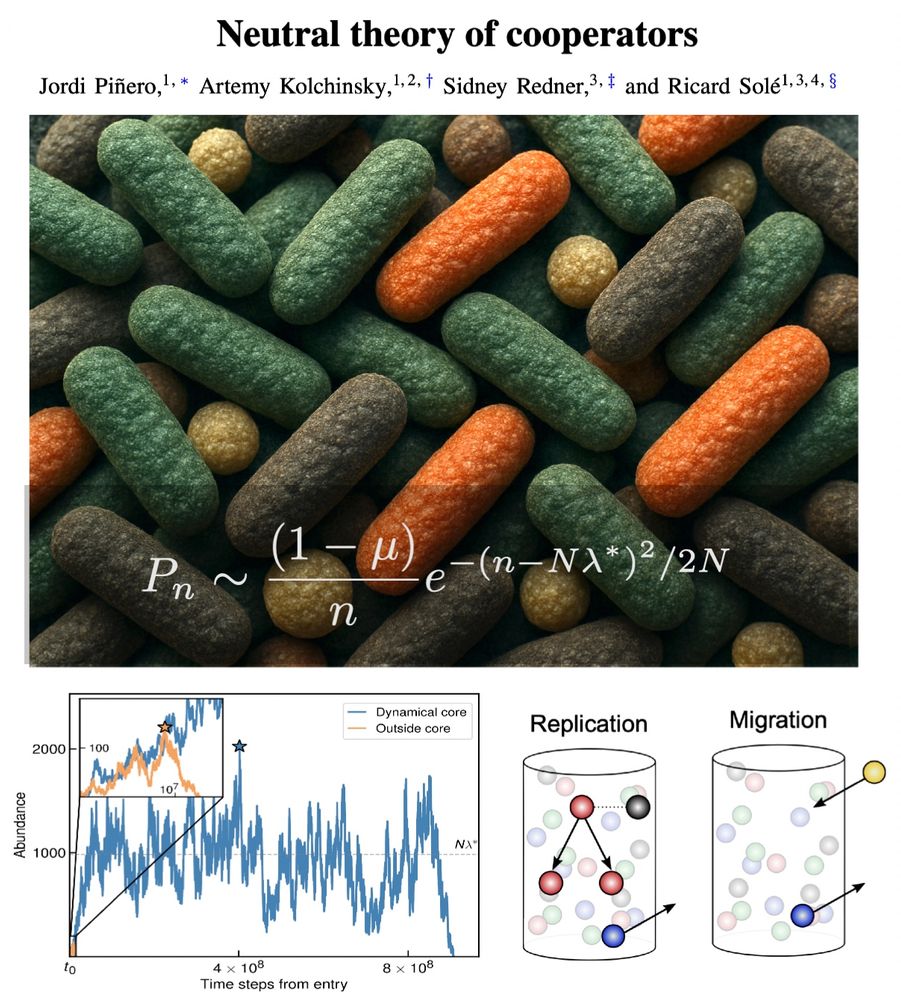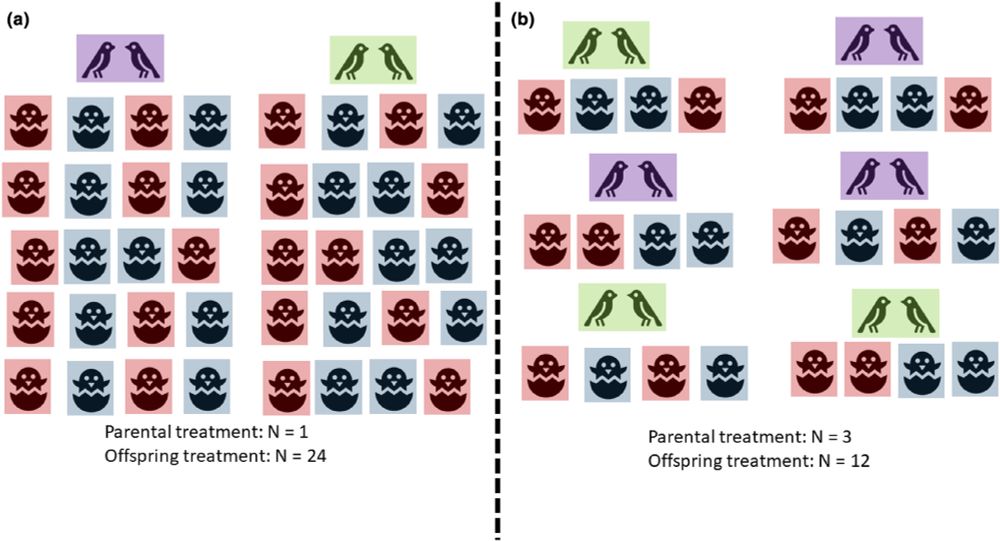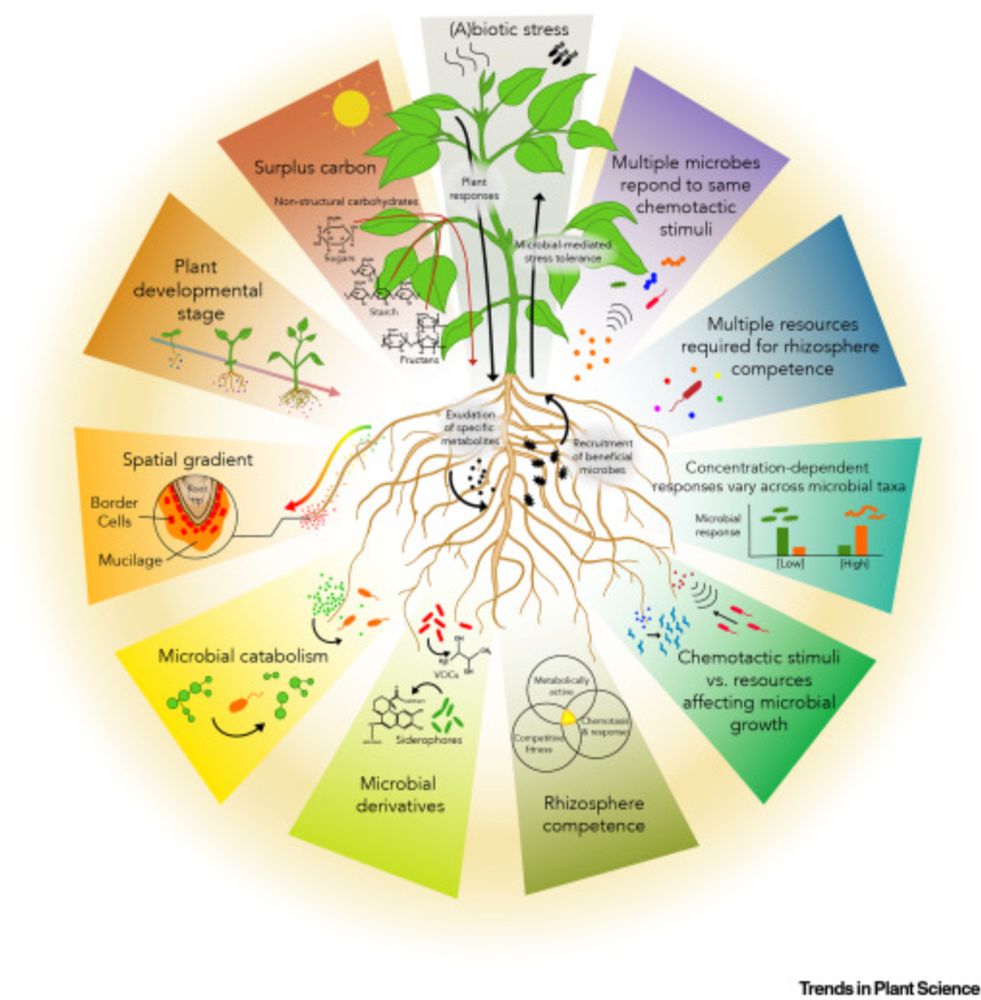Congrats! I jumped to comment on your great Plant&Soil paper to mention that it is key to evaluate myco colonization in collaboration gradient, which you agreed. Yet, this one does not use myco colonization but infers the collaboration gradient. There is variation in diameter regardless of myco too
08.10.2025 05:37 — 👍 0 🔁 0 💬 1 📌 0

What if the chaotic-looking patterns in dryland vegetation were actually hiding a deep order? Check our new @pnas.org paper on "disordered hyperuniformity": a hidden structure with big implications for sustainability in Earth’s most fragile ecosystems.https://www.pnas.org/doi/10.1073/pnas.2504496122
07.10.2025 16:17 — 👍 14 🔁 2 💬 1 📌 0
📣Now finally with peer-review stamp of approval.
Thanks @ashish-malik.bsky.social for being the editor for this paper.
soil.copernicus.org/articles/11/...
02.10.2025 13:21 — 👍 5 🔁 3 💬 1 📌 0

A global database of soil microbial phospholipid fatty acids and enzyme activities - Scientific Data
Scientific Data - A global database of soil microbial phospholipid fatty acids and enzyme activities
If you are in need of soil microbial data relating to PLFAs or enzyme activities, check out our latest paper that provides an open-access global database of data form around the world. Thanks very much to the long list of collaborators who made this happen! www.nature.com/articles/s41...
27.09.2025 04:06 — 👍 14 🔁 8 💬 1 📌 1

How can we build a general theory of mutualistic communities? After five years, we finally completed a new Neutral Theory of Cooperation that is fully solved analytically and displays remarkable properties @jordipinero.bsky.social @artemyte.bsky.social @manlius.bsky.social arxiv.org/abs/2506.09737
12.06.2025 20:16 — 👍 69 🔁 27 💬 2 📌 0

Soil Carbon Availability Drives Depth‐Dependent Responses of Microbial Nitrogen Use Efficiency to Warming
🔗 buff.ly/ZjLu7Nv
24.09.2025 12:25 — 👍 3 🔁 2 💬 1 📌 0
Long‐Term Drought Persistently Shifts Plant and Soil Microbial Communities but Has Limited Impact on CO2 Fluxes Under Subsequent Drought
buff.ly/oax2DpO
@marigliesch.bsky.social @frantecol.bsky.social
19.09.2025 16:59 — 👍 5 🔁 3 💬 0 📌 1

Proud to share our paper: Drought intensity shapes soil legacy effects on grassland plant and soil microbial communities and their responses to future drought, out now in @globalchangebio.bsky.social doi.org/10.1111/gcb.... (1/n)
19.09.2025 20:12 — 👍 32 🔁 16 💬 2 📌 0
NEW PAPER 🚨 Curious how plant root exudation and soil texture might interact to form dynamic anoxic microsites in the #rhizosphere, and what they might mean for the fate of soil #carbon, nutrient or contaminent in #soils? Check out @soiltycoon.bsky.social's new paper in SBB: doi.org/10.1016/j.so...
09.09.2025 18:04 — 👍 18 🔁 11 💬 0 📌 1

Intensified Aridity Hinders Soil Microbes From Improving Their Nitrogen Use Efficiency
🔗 buff.ly/lqLCwwn
11.09.2025 23:25 — 👍 4 🔁 2 💬 1 📌 0

Roots: metabolic architects of beneficial microbiome assembly
Abstract. The increasing demand for sustainable agricultural practices has driven a renewed interest in plant–microbiome interactions as a basis for the ne
🔬🌱Our review “Roots: metabolic architects of beneficial microbiome assembly” led by PhD candidate Melissa Uribe Acosta @plantphys.bsky.social discusses plant mechanisms of root microbiome selection. Co-authors: @cornepieterse.bsky.social Jiayu Zhou Alberto Pascale.
academic.oup.com/plphys/artic...
11.09.2025 21:38 — 👍 30 🔁 10 💬 0 📌 1

Schematic illustration of the different magnitudes and mechanisms of soil organic carbon (SOC) increase resulting from 180-year nitrogen and phosphorus fertilization
⚒️ Article: Nitrogen and Phosphorus fertilization is an effective pathway to increase soil carbon sequestration
www.nature.com/articles/s41...
10.09.2025 15:00 — 👍 10 🔁 4 💬 0 📌 0
LinkedIn
This link will take you to a page that’s not on LinkedIn
🪱 Publication Announcement! 🌱🍄🟫
Book chapter “Soil biology, health and ecosystem services: an overview”. We detail the process of selecting indicators to assess soil health in agricultural systems, applied to four key soil functions.
📂 Open access link:
lnkd.in/eXW6VQzu
Have a nice read!
30.08.2025 16:47 — 👍 8 🔁 4 💬 0 📌 0
Fast Decomposition of Nitrogen‐Rich Mineral‐Associated Organic Matter in Soils
🔗
29.08.2025 12:25 — 👍 2 🔁 1 💬 0 📌 0

Refining Amino Sugar‐Based Conversion Factors for Quantification of Microbial Necromass Carbon in Soils
🔗 buff.ly/h98n4CQ
28.08.2025 23:25 — 👍 2 🔁 1 💬 0 📌 0

Effective, efficient, and fair peer reviewing 2023
Effective, efficient, and fair peer reviewing Ben Bond-Lamberty Based on a presentation at the AGU Early Career Scientist Workshop, 2019 1
Scientists are expected to do peer reviewing but no one tells you HOW. After talking with several folks about this today at #AGU24 , it seems a good time to link to this presentation I made several years ago -- feel free to use/share! docs.google.com/presentation...
12.12.2024 22:18 — 👍 145 🔁 52 💬 5 📌 3

Impact of a 2°C Warmer Climate on the Fine Root System of European Beech, Sessile Oak, Scots Pine, and Douglas Fir in Central European Lowland Forests - Ecosystems
Climate change increasingly exposes Central European forests to drought and heat stress, causing vitality decline and increased mortality of key tree species. How warming alters the size and dynamics of tree root systems is not well known. In a root coring and ingrowth core study in 24 stands, we compared fine root biomass (FRB), necromass, productivity, longevity and morphology in mature stands of European beech, sessile oak, Scots pine, and Douglas fir in two German lowland regions differing by 2 °C in mean annual temperature, which may evidence long-term thermal acclimation. FRB was significantly smaller in the warmer region in beech and Douglas fir, while cumulated fine root surface area was reduced in pine, Douglas fir, and beech, but not in oak. Both root productivity and longevity were reduced in the warmer region in Douglas fir and pine, indicating vulnerability to warming. Beech showed a non-significant productivity reduction, while longevity slightly increased. Oak tended to increase productivity and longevity, indicating highest resilience to warming. Fine root system size was more plastic than root morphology, which differed only slightly between the regions. Using reductions in root longevity and in fine root productivity in the warmer region as criteria, species are ranked for their belowground vulnerability to warming as: Scots pine > Douglas fir > European beech > sessile oak. We conclude that Central Europe’s major timber species differ largely in their belowground vulnerability to warming, with conifers being more sensitive than broad-leaved species.
Impact of a 2°C Warmer Climate on the Fine Root System of European Beech, Sessile Oak, Scots Pine, and Douglas Fir in Central European Lowland Forests - Ecosystems
25.08.2025 18:39 — 👍 6 🔁 4 💬 0 📌 0
Was so rewarding getting to work with a team of brilliant ecologists (@dudney-joan.bsky.social @lauradee.bsky.social @jebyrnes.bsky.social @katherinesiegel.bsky.social )
to think through how to use causal inference to attribute ecological changes to climate change. Hope this framework helps!
22.08.2025 19:48 — 👍 32 🔁 10 💬 1 📌 0

Principles of experimental design for ecology and evolution
Here I argue that we do not discuss experimental design, often until it is too late. This editorial seeks to begin a conversation about how and where to replicate appropriately.
I wrote (ranted) on experimental design as I was frustrated as an editor at how little guidance students were getting. I underestimated the interest in the issue: it has been downloaded 10,000+ times! Clearly it’s something we need to be talking about more. onlinelibrary.wiley.com/doi/full/10....
07.11.2024 21:24 — 👍 319 🔁 153 💬 15 📌 13

Mechanisms that potentially contribute to the maintenance of interactions between bacteria, ectomycorrhizal fungi (EcMF), and land trees across varied developmental periods.
“…when organisms interact can largely determine how they interact.”
#Viewpoint: Is it all about timing? Identifying the symbiosis critical points that govern interactions among #bacteria, ectomycorrhizal #fungi, and land #trees
By Louis Berrios 👇
📖 nph.onlinelibrary.wiley.com/doi/10.1111/...
08.08.2025 13:01 — 👍 18 🔁 12 💬 1 📌 0
I don’t know who needs this right now, but I really enjoy browsing “Paper Skygest”, a feed of posts on academic papers *from people you follow*. I think it’s what a lot of us are actually here for
06.08.2025 11:35 — 👍 89 🔁 37 💬 9 📌 2

Limited carbon sequestration potential from global ecosystem restoration - Nature Geoscience
The maximum carbon sequestration potential from global terrestrial ecosystem restoration efforts until 2100 is 96.9 Gt, which is equivalent to 3.7–12.0% of anthropogenic emissions until then, accordin...
This paper is getting attention for suggesting ecosystem restoration won't help with mitigation, but restoration is still *critical* for adaptation.
Restoring coastal wetlands helps reduce risks from sea level rise and hurricanes, restoring urban forests helps reduce risks from extreme heat, etc...
01.08.2025 19:03 — 👍 71 🔁 35 💬 3 📌 1
En, De, עב | environmental microbiology | soil C and N | atmospheric trace gases | deserts | mountain climbing | senior research scientists at BC CAS, Czechia
linktr.ee/roey.angel
Functional Ecology of Forests and Trees, and dendroecology @csic.es @INIA_es Madrid 🇪🇺
dmartinbenito.wordpress.com
@BeetleBark in the X Bird site for now
Scientist & skeptic. Dad. Book addict. Pathologically curious. Origins and Evolution of Complexity, Synthetic Transitions, Liquid Brains, and Earth Terraformation. ICREA + SFI professor. Author. Secular humanist.
Researching tree physiology and forest carbon sequestration at CSIC, ES
climate scientist
posts 100% my own
🇨🇦 is my home
distinguished professor & chair, Texas Tech
chief scientist, The Nature Conservancy
board member, Smithsonian NMNH
alum, UToronto and UIUC
author, Saving Us
marine ecologist, online bon vivant, dad, ❤️ teaching #datasci & #rstats, byrneslab.net | floatingforests.org #BlackLivesMatter @jebyrnes in other places https://linktr.ee/jebyrnes
Home to five Nordic ecology societies and journals @avianbiology.bsky.social, @nordicjbotany.bsky.social, @oikosjournal.bsky.social, @wildlifebiology.bsky.social and @ecography.bsky.social.
www.nordicsocietyoikos.org
Asst Prof #Fungi #ClimateChange #Latina #Hermosillense 🍄🌎🧶👩🏽🔬🇲🇽 - she/her - guinea pig fan - mom 🥰🥰 P.D. posteo en inglés ww.fungiloverlab.com
An open access journal covering forest ecosystems, forest communities, forest environment, remote sensing, climate change, big data (2024JIF=4.4)
https://www.sciencedirect.com/journal/forest-ecosystems
Building personalized Bluesky feeds for academics! Pin Paper Skygest, which serves posts about papers from accounts you're following: https://bsky.app/profile/paper-feed.bsky.social/feed/preprintdigest. By @sjgreenwood.bsky.social and @nkgarg.bsky.social
Professor of Forest Vegetation Ecology, working at the Swedish University of Agricultural Sciences. 🇺🇸 + 🇸🇪
https://www.slu.se/en/profilepages/g/michael-gundale/
Food and science (but not food science). Views my own.
Forest ecologist, plant demographer, dendrochronologist. Assoc. Professor at the University of Arizona, Laboratory of Tree-Ring Research - views are my own. Scientist at the intersection of the climate and biodiversity crises. Mom, dancer, gardener, cook.
We are curious how interactions among organic matter, microbes, and minerals in soil drive and respond to climate change |
PI: Marco Keiluweit |
This account shares updates and news from the team |
University of Lausanne 🇨🇭|
https://wp.unil.ch/bgc
Conference on ecology of soil microorganisms in Helsinki, Finland.
June 15-19 2025
Networking accross scales
https://www.luke.fi/esm2025
#esm2025
Postdoc at SLU Umeå • Microbial Ecology • Climate Change • Carbon Cycle • Enjoying Swedish Nature 🏕️
Soil carbon & climate feedbacks | Prof at Oregon State Univ | PhD at UC Berkeley | climbing, skiing, and all things outdoors 🌿🍃🍂 kgeorgiou.com
Spanish Association of Terrestrial Ecology, promoting scientific research in #Ecology since 1989.
Publisher of the journal @ecosistemas-aeet.bsky.social
Web: https://www.aeet.org/es/
Social evolution, social aging & the benefits of social network ties. Professor @crab-exeter.bsky.social, Dept. of Psych, Uni. of Exeter. Big team science collaborations: #MacaqueNet #CBRU. Editor: Animal Behaviour. She/her. http://linktr.ee/laurenbrent






















